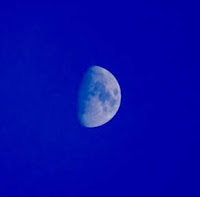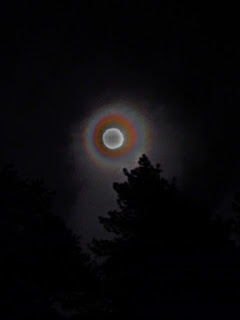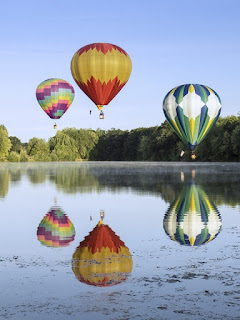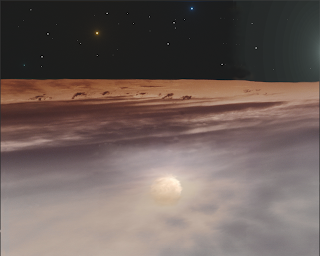 |
| "Moonlight on Dunes", digital art by J.D. |
The full moon is a welcome sight for most of us, despite its ancient reputation for bringing out werewolves, madmen, and other odd phenomena. Certainly this year has given us some interesting full moons. If you are a moon watcher, you know that the moon has phases. Many calendars show those phases. sometimes we don't see the moon at all. This is the "dark of the moon", shown as a black circle on the calendar and called "New moon". The changes to the moon take place on its right side. First a thin line of light appears along that side, gradually becoming a bright crescent, while the rest of the moon remains dark. This is sometimes called "first crescent". The crescent continues to grow, a process called a waxing moon. You may have seen pictures in children's books that show a crescent moon with a man's face drawn inside the curve of the crescent. J.J. happened to catch the moon at a time that may explain why people have seen this particular appearance of the "Man in the Moon".
More and more of the moon's surface becomes revealed, until we see a half moon. Craters and other features of the moon's surface become prominent. By the time the side of the moon facing us is displayed as a full moon, the markings on the moon's surface are even more distinct, leading to a new version of the "Man in the Moon".
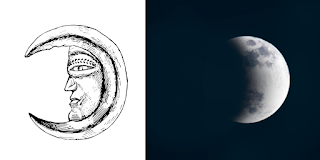 |
| Crescent moon |
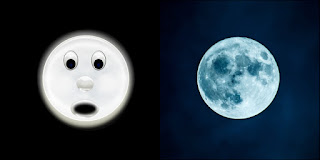 |
| Full moon |
But the full moon doesn't last long. Darkness begins to cover the moon's surface, again from the right. Soon there is just another crescent, facing the opposite direction. This is sometimes called "last crescent". The darkening process is called a waning moon. (The terms "waxing" and "waning" are important if you hope to photograph the moon. To see the moon in conjunction with sunrise or during the early morning, it is best done when the moon is waxing. A waning moon sometimes produces a vision of the moon in late afternoon or at sunset.) J.D. captured this one in late afternoon. Eventually the moon disappears into darkness again.
The best time to photograph the moon is during the "blue hours" before dawn and after sunset. Get to your spot — well away from the reflections from city lights — early in both cases. As you wait for the sun to go down, you may catch the moon and sun in the same photograph. If you are patient in the early morning, you may get the moon and the rising sun in the same exposure.
Here is a picture J.J. got of a ring around the moon.
Moonlight, especially from a full moon, is more powerful than you might imagine. We had one full moon this spring that was almost bright enough to read by. To get a good photograph, stand with your back to the moon and allow your eyes to adjust to the light. Make the most of features that are in varying degrees of shadow. Use a tripod to keep the camera steady and a remote shutter release. Bracket your shots with both longer and shorter exposures to get the most interesting effects.
The best time to photograph the moon is during the "blue hours" before dawn and after sunset. Get to your spot — well away from the reflections from city lights — early in both cases. As you wait for the sun to go down, you may catch the moon and sun in the same photograph. If you are patient in the early morning, you may get the moon and the rising sun in the same exposure.
Here is a picture J.J. got of a ring around the moon.
Moonlight, especially from a full moon, is more powerful than you might imagine. We had one full moon this spring that was almost bright enough to read by. To get a good photograph, stand with your back to the moon and allow your eyes to adjust to the light. Make the most of features that are in varying degrees of shadow. Use a tripod to keep the camera steady and a remote shutter release. Bracket your shots with both longer and shorter exposures to get the most interesting effects.
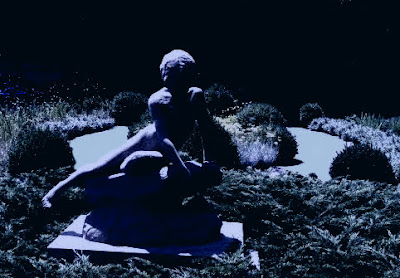 |
| Moonlight in the Garden, photo by J.J. |
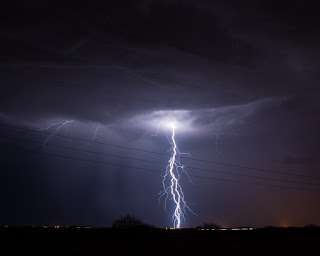 |
| Lightning, public domain photo |
If you live at the right latitudes to see either the Aurora Borealis or the Aurora Australis — or plan to travel to these regions — you can be treated to some outstanding sky displays. The luminous curtains, swirls, and bands are caused by atoms in the atmosphere that have been excited by emissions of electrons along the planet's magnetic field lines. Since the North Magnetic Pole is rapidly changing position at this time, this may be a very good year for auroras. I suggest using a large clipboard or lap-desk with a clamp-on high-intensity battery-powered light, and dark-colored construction paper and chalk pastels to capture images of the lights. The sides of the chalk can capture the movement of the "curtains" of light, while the points can put in finer details. I know I talk a lot about sketching, but the details of images fade quickly and are best caught in a form that will later stimulate memories. Put in some sort of detail in the low foreground — mountains, trees, a city profile, etc. — to show the vastness of the display. A lighted tent, tepee, or igloo can be a nice touch. And finger-less gloves are a hand-saver.
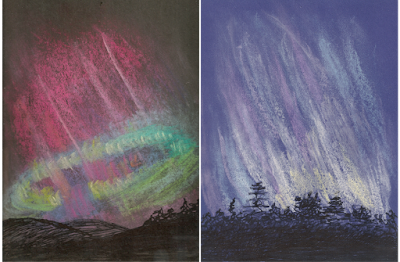 |
| Aurora sketches by Annake |
 |
| Fireworks! |
 |
| Geese in flight (public domain photo) |
There is no shortage of man-made objects flying through the skies as well: airplanes, seaplanes, helicopters, crop-dusters, fire-fighting equipment, etc. There are scientific devices like weather balloons. There are also recreational vehicles like gliders, para-sails, hang-gliders, parachutes, zip-lines and drones. Any of these has the potential for making an interesting or exciting picture.
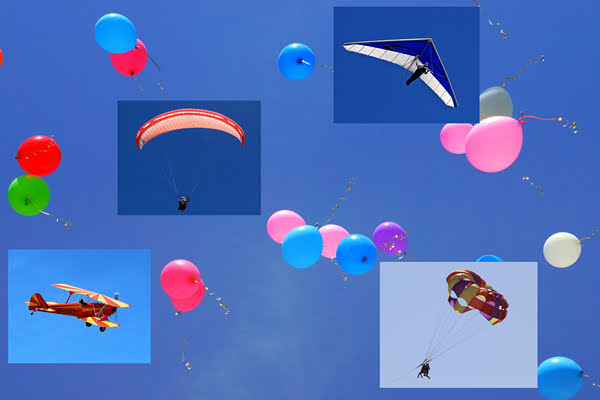 |
| Things you might see if you look up... |
Here is a colorful photo of hot-air balloons just beginning to rise into the air.
So I encourage you to keep your eyes on the skies. You never know when you will be in just the right place at just the right time.
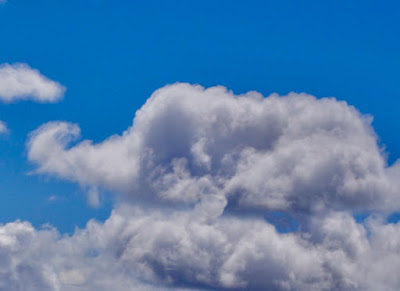 |
| Baby elephant in the clouds, photo by J.J. |
annakes_garden@yahoo.com or annakesgnome@gmail.com
Have a wonderful summer.
All photos public domain unless otherwise credited.
 This post by Annake's Garden is licensed under a Creative Commons Attribution-NonCommercial-ShareAlike 3.0 Unported License.
This post by Annake's Garden is licensed under a Creative Commons Attribution-NonCommercial-ShareAlike 3.0 Unported License.
